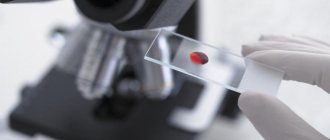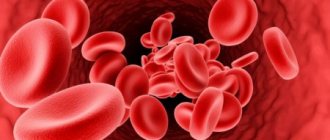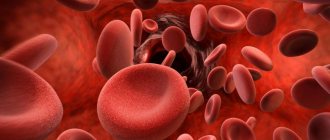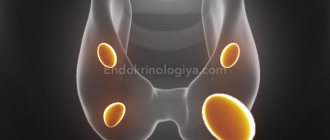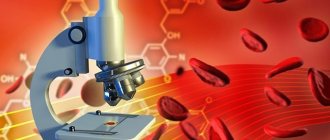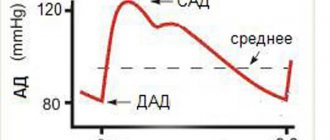0
Author of the article: Marina Dmitrievna
2017.09.07
4 385
Blood analysis
Blood is the biological medium that gives us the opportunity to live. Using the heart and blood vessels, it nourishes the body’s tissues with useful microelements and oxygen, which cells need for normal division and growth. At the same time, the blood cleanses the organs of metabolic products and carbon dioxide, which then leave the body through the kidneys and lungs.
Of great importance for the correct redox process is the density of the blood and the speed of its movement through the vessels. The consistency of plasma is influenced by various factors, and the correct functioning of the entire organism depends on its viscosity. Too thick plasma provokes the development of many serious diseases:
- Myocardial infarction.
- Stroke.
- Thrombosis.
Viscous blood
What is hematocrit
Blood is made up of red cells called red blood cells. Hematocrit determines the level of red blood cells in the blood. These data may not be present in the overall analysis, so additional research is being conducted.
What is the name of the blood viscosity test? It's called a hematocrit test. In addition, a comprehensive coagulation test can be taken, which is called a “blood coagulogram,” which clearly shows the level of coagulation of human blood fluid and the activated partial thromboplastin time. Analyzes indicate the percentage of red blood cells. When indicated above the norm, this indicates changes in the blood.
The average volume of red blood cells can be individual for each person. The liquid part of blood is called plasma; it is most abundant in human fluid, up to 60%. The remaining 40% consists of red blood cells (99%) and a combination of platelets and leukocytes (1%).
Any blood is suitable for analysis of APTT; it is placed in a special tube and then in a centrifuge. After it stops, a separation of red blood cells is observed, which begin to settle. Using these indicators, you can determine how much plasma and blood cells are in the blood. The hematocrit level is calculated using a certain formula.
Traditional methods
Thick blood syndrome can be treated using folk recipes based on the properties of medicinal plants. Before using such herbal medicine techniques, it is recommended to consult a doctor and make sure there are no contraindications.
The following folk recipes can be used to thin thick blood:
- tincture of meadowsweet (or lobaznik);
- herbal collection of equal parts of yellow sweet clover, meadow clover flowers, meadowsweet grass, valerian roots, lemon balm, narrow-leaved fireweed and hawthorn fruits;
- infusion of willow bark;
- infusion of horse chestnut flowers;
- nettle infusion;
- tincture of nutmeg.
Many people do not even suspect that blood can be different, and not only by group or Rh factor, but also by such properties as viscosity. In fact, blood is not water or other “ordinary” liquid with a constant density.
It has a very complex composition, the study of which is carried out by individual scientists, devoting their entire lives to it. And blood viscosity is not the last place in these studies, because it is a vital indicator.
The concept of viscosity itself can be represented as the density of a liquid and its ability to spread over a surface or change its shape. For example, oil has a higher viscosity than water, so if we spill it on the table, we will get a small and rather “thick” puddle. Having spilled water, we will only see a wet surface - such a thin layer of water will be obtained.
Blood is a complex liquid that consists of many elements, the main one of which is water. Its content in the blood is more than 90%. We get water from the outside, so its quantity and quality directly affects the viscosity of the blood, and then we will look at how exactly.
Water is found mainly in plasma, the main fluid in the blood. But plasma itself is much thicker than water because it has a much more complex composition. In addition, the blood contains a huge number of blood cells, which themselves are not liquid, but only “fill” the blood. These are myriads of red blood cells, leukocytes, platelets, monocytes and many other types of cells. It is clear that the more there are per unit volume of blood, the thicker the blood.
This was the theory, but what are the specific causes of changes in blood viscosity? There are many of them, but the most common ones can be identified:
- Poor water quality. Bad water, that is, chlorinated, with a high content of various impurities, simply dirty, or carbonated has a bad effect on the quality of the blood. But water is the main liquid in its composition. As a result, we get the same blood as the water we drink.
- A decrease in the formation of enzymes in the body can be safely attributed to the disease. As a result, a lot of incompletely broken down proteins, amino acids and other molecules accumulate in the blood, and this makes the blood thicker. In addition, the structure of blood cells is disrupted, and red blood cells can stick together, and we will consider the bad consequences of this further.
- Reducing water intake greatly increases blood viscosity. This can be, for example, in a hot climate, when a person loses a lot of fluid through sweat, but drinks little. In the desert, this can lead to death in a few hours, because the blood is too thick and cannot move through most vessels, and the heart is not able to pump such a thick “oil.”
- Poor absorption of water - it also happens that a person drinks a lot, but there is little benefit from it. It's just a pathology that needs to be treated.
- Increased content in the blood of a large number of various unnecessary “additives” - cholesterol, uric salts and other acids, bacteria and much more. It is their number that is looked at in a blood test, and this is an important factor.
Knowing at least a little about the work of the human cardiovascular system, at least at the level of a school anatomy course, you can independently see most of the consequences.
The first thing that comes to mind, and this is really one of the main complications, is the formation of blood clots. Thick blood easily clogs small vessels, and the clumping of red blood cells makes this process even more dangerous. Blood clots are the cause of heart attacks and strokes, the most “popular” causes of death today. That is why the treatment of such patients necessarily includes blood thinning measures.
Thick blood does not penetrate small vessels well, as already mentioned. This means that those tissues that were supplied with oxygen and nutrients from these vessels begin to starve. This will immediately affect the activity of the entire organ, and since the blood is the same everywhere, almost all organs will suffer - their normal functioning will simply be disrupted. As a result, there is pain and various diseases of various organs, and poor general health is guaranteed.
Blood is the main frontier where the immune system fights infection. Increased viscosity greatly reduces its capabilities. Due to the reduced fluid level, the concentration of toxins and microorganisms per unit volume increases.
Our health depends on the quality of our blood. It is not for nothing that from time immemorial it was considered a special, life-giving liquid, and was endowed with supernatural properties. In fact, this is practically true. But blood with abnormal viscosity loses many of its properties, and this sooner or later leads to various diseases.
Blood viscosity can be influenced. As you can see, the amount of liquid you drink and its quality are of particular importance in this regard. Even in the desert, where blood becomes thick very quickly and can kill a person in a matter of hours, drinking enough fluid can maintain viscosity at a normal level.
Under normal conditions, a person should drink at least one and a half liters of water per day. You can, of course, drink not only water, but also other liquids. Green tea or any other herbal tea is especially useful for thinning the blood. Natural juices are very good, they also give the body a lot of vitamins. By the way, vitamin deficiency itself can cause increased blood viscosity.
You need to control your diet and not get carried away with too fatty meat. A balanced diet will provide the right amount of fats, proteins and carbohydrates, and will help maintain normal cholesterol levels. Poultry and fish are the best options for meat. Sea kale has long been considered a good remedy for thick blood.
Other products include nuts. They contain many minerals and proteins, and in addition they contain arginine. It is involved in the formation of nitric oxide, which affects blood viscosity. The well-known onions and garlic are useful here too - they can also affect viscosity and reduce the process of red blood cell gluing.
For people suffering from heart disease, and for the prevention of heart attacks and strokes, the doctor must prescribe daily aspirin or other drugs based on it, for example Cardiomagnyl. The fact is that aspirin thins the blood well, and in such patients the risk of blood clots is noticeably reduced.
Increased blood viscosity is not a diagnosis, but it does indicate that action needs to be taken. Often, correcting nutrition and improving the quality of drinking water can correct the situation. In any case, you should take this seriously and undergo an examination to identify the causes. Particular attention should be paid to the liver - it plays the role of a filter and the quality of blood largely depends on its work.
Hematologist
Hematologist
Samara State Medical University (SamSMU, KMI)
Level of education - Specialist1993-1999
"Hematology"
Russian Medical Academy of Postgraduate Education
Based on the composition, thickness of blood and its other indicators, one can determine the state of a person’s health, the presence of various diseases and life-threatening processes, the location of lesions, etc. Diagnosis of almost any ailment begins with a blood test.
One of the varieties of this diagnostic method is a blood density test. How is this type of laboratory research carried out, what is it called, is preparation necessary for it? Let's answer these questions in more detail.
Analysis readings and norm
The HCT blood test determines hemoglobin levels. It is mandatory for pregnant women. The analysis is able to identify a disease that leads to deviations from the norm in hematocrit values.
The study may be ordered under other circumstances:
- To identify the degree of anemia if the level is low and polycythemia if the level is elevated.
- After treatment, to determine the effectiveness, in this case the total number of red blood cells should also change.
- If it is necessary to carry out a blood transfusion or choose another method of therapy.
- To determine the degree of dehydration of the body.
The norm may be different, it depends on the age, gender and individual characteristics of the individual organism.
If we take men, then the normal indicators will be the following data - 44-50%. Blood viscosity in women is considered normal at the following levels - 36-42%. The hematocrit of infants averages 54-68%.
how to determine blood thickness using a blood test
Whatever your illness, the first test that a competent doctor will send you for will be a general (general clinical) blood test, says our expert - cardiologist, doctor of the highest category Tamara Ogieva.
Blood for general analysis is taken venous or capillary, that is, from a vein or from a finger. The primary general analysis can be taken without an empty stomach. A detailed blood test is given only on an empty stomach.
For biochemical analysis, blood will have to be donated only from a vein and always on an empty stomach. After all, if you drink, say, coffee with sugar in the morning, the glucose level in your blood will certainly change and the analysis will be incorrect.
Ideally, it is recommended to take blood for a general blood test after a short rest, since some indicators may change with excitement and physical stress.
A competent doctor will definitely take into account your gender and physiological condition. For example, in women during “critical days,” the ESR increases and the platelet count decreases.
A general analysis provides more information about inflammation and the state of the blood (susceptibility to blood clots, the presence of infections), and biochemical analysis is responsible for the functional and organic state of internal organs - liver, kidneys, pancreas.
General analysis indicators:
1. HEMOGLOBIN (Hb) is a blood pigment found in erythrocytes (red blood cells), its main function is the transfer of oxygen from the lungs to the tissues and the removal of carbon dioxide from the body.
Normal values for men are 130-160 g/l, women - 120-140 g/l.
Reduced hemoglobin occurs with anemia, blood loss, hidden internal bleeding, damage to internal organs, for example, kidneys, etc.
It can increase with dehydration, blood diseases and some types of heart failure.
2. ERYTHROCYTES - blood cells that contain hemoglobin.
Normal values are (4.0-5.1) * 10 to the 12th power/l and (3.7-4.7) * 10 to the 12th power/l, for men and women, respectively.
An increase in red blood cells occurs, for example, in healthy people at high altitudes in the mountains, as well as in congenital or acquired heart defects, diseases of the bronchi, lungs, kidneys and liver. The increase may be due to an excess of steroid hormones in the body. For example, with Cushing's disease and syndrome, or during treatment with hormonal drugs.
Decreased - with anemia, acute blood loss, with chronic inflammatory processes in the body, as well as in late pregnancy.
3. LEUCOCYTES - white blood cells, they are formed in the bone marrow and lymph nodes. Their main function is to protect the body from adverse effects. The norm is (4.0-9.0) x 10 to the 9th power /l. Excess indicates the presence of infection and inflammation.
There are five types of leukocytes (lymphocytes, neutrophils, monocytes, eosinophils, basophils) , each of them performs a specific function. If necessary, a detailed blood test is done, which shows the ratio of all five types of leukocytes.
For example, if the level of leukocytes in the blood is increased, a detailed analysis will show which type has increased their total number. If due to lymphocytes, then there is an inflammatory process in the body; if there are more eosinophils than normal, then an allergic reaction can be suspected.
Why are there many leukocytes?
There are many conditions in which changes in white blood cell levels are observed. This does not necessarily indicate illness. Leukocytes, as well as all indicators of general analysis, react to various changes in the body. For example, during stress, pregnancy, or after physical exertion, their number increases.
An increased number of leukocytes in the blood (also known as leukocytosis) also occurs with:
+ malignant neoplasms and leukemia,
+ taking hormonal medications, some heart medications (for example, digoxin).
But a low number of white blood cells in the blood (or leukopenia): this condition often occurs with a viral infection (for example, the flu) or taking certain medications, for example, analgesics, anticonvulsants.
4. PLATELETS - blood cells, an indicator of normal blood clotting, are involved in the formation of blood clots.
Normal amount - (180-320) * 10 to the 9th power / l
An increased amount occurs when:
chronic inflammatory diseases (tuberculosis, ulcerative colitis, cirrhosis of the liver), after operations, treatment with hormonal drugs.
the effects of alcohol, heavy metal poisoning, blood diseases, kidney failure, liver diseases, spleen diseases, hormonal disorders. And also under the influence of certain medications: antibiotics, diuretics, digoxin, nitroglycerin, hormones.
5. ESR or ROE - erythrocyte sedimentation rate (erythrocyte sedimentation reaction) - this is the same thing, an indicator of the course of the disease. Typically, ESR increases on days 2-4 of the disease, sometimes reaching a maximum during the recovery period. The norm for men is 2-10 mm/h, for women - 2-15 mm/h.
infections, inflammation, anemia, kidney disease, hormonal disorders, shock after injuries and operations, during pregnancy, after childbirth, during menstruation.
with circulatory failure, anaphylactic shock.
Biochemical analysis indicators:
6. GLUCOSE - it should be 3.5-6.5 mmol/liter. Decreased - with insufficient and irregular nutrition, hormonal diseases. Increased in diabetes mellitus.
7. TOTAL PROTEIN - norm - 60-80 grams / liter. Decreases with deterioration of the liver, kidneys, malnutrition (a sharp decrease in total protein is a frequent symptom that a strict restrictive diet clearly did not benefit you).
8. TOTAL BILIRUBIN - normal - no higher than 20.5 mmol/liter shows how the liver is working. Increased in hepatitis, cholelithiasis, destruction of red blood cells.
9. CREATININE - should not be more than 0.18 mmol/liter. The substance is responsible for the functioning of the kidneys. Exceeding the norm is a sign of kidney failure; if it falls short of the norm, it means you need to increase your immunity.
What should a child be able to do from the first month to one year?
From the first days of the baby’s life, parents begin to worry: is he developing correctly? "KP"-Health" comes to the aid of young mothers and fathers
Five main consequences of a sedentary lifestyle
And why does the prostate gland suffer the most from physical inactivity?
Sanatoriums in Russia with treatment: the best health resorts in the country
In this review, we have collected for you the best sanatoriums in Russia with treatment for all main types of health problems: from the heart and blood vessels to the nervous system and musculoskeletal system
Coxsackievirus in Turkey: More than 800 Russians complained of health problems
Most people suspect they are infected with the Coxsackie virus.
Nine blood indicators that tell you everything about you
What you can read about your health from the most informative analysis
Seven Real Causes of High Blood Pressure
Delicious food, back problems, reaction to the weather? Why, in fact, every second of us becomes hypertensive, experts say
Cancer research expert: The risk of brain tumors is higher among those who fly more often
But the connection between the use of gadgets and brain cancer, according to the latest data, has not been confirmed
Five common situations in which yoga can help you
On International Yoga Day, we show simple exercises that will help you out in difficult moments [video]
If there are any signs, it is recommended to take a hematocrit test?
Now we know what a blood viscosity test is called. But for what signs it is prescribed, it’s worth finding out.
The study can be prescribed based on the person’s health status:
- with constant weakness and fatigue;
- if a person often loses consciousness;
- with pale skin;
- there is a lack of oxygen, which is accompanied by shortness of breath;
- decreased vision;
- regular dizziness and headaches;
- enlarged spleen;
- feeling of a rush of blood to the face;
- dry mouth and constant thirst;
- When urinating, little urine is released.
Clinical picture
The problem under consideration does not have specific symptoms. That is, the symptoms of thick blood are not classified as a separate group. The following signs may indicate the occurrence of an increased hematocrit:
- strong thirst;
- drying of mucous membranes and skin;
- the appearance of shortness of breath;
- low exercise tolerance, muscle weakness;
- active heartbeat for no obvious reason;
- the appearance of unpleasant sensations localized behind the chest;
- heaviness in the head;
- feeling of chills in the extremities.
A child with thick blood becomes more whiny and drowsy.
Symptoms of increased plasma viscosity are not specific; they can also occur in other diseases. The patient complains of:
- Chronic fatigue even after long sleep.
- Apathy.
- Reduced ability to work.
- Headaches and dizziness.
- Transparency of the skin.
- Cold extremities even at high ambient temperatures.
- Poor memory, slow thinking.
- Depression.
- Dry skin.
- Constant feeling of thirst.
- External manifestation of thrombosed veins.
If you notice at least a few of the above symptoms, immediately seek help from a doctor in order to quickly prevent the negative consequences of thick plasma.
Causes of low hematocrit
If the hematocrit is low, what does this mean, what reasons contribute to this and is it dangerous? These questions often bother many patients.
If iron enters the body in insufficient quantities, then we can talk about a decrease in hematocrit. In addition, blood viscosity is affected by a decrease in hemoglobin synthesis. Representatives of the fair sex who have been on strict diets for a long time or practice therapeutic fasting are especially susceptible to this condition.
In childhood, the hematocrit may be reduced as a result of the following reasons:
- Poor nutrition, in which the child’s body receives few foods containing iron. These are products such as meat, apples, pomegranate juice, buckwheat porridge.
- A period of accelerated growth.
- Diseases of the digestive system in which poor absorption of iron occurs.
Reduced hematocrit is not a separate disease. But it can have a negative impact on the immune system, poor blood clotting and other dangerous consequences. Therefore, at any age it is necessary to monitor the correctness of your diet.
Also, the blood viscosity coefficient decreases due to large blood losses. They occur against the background of the following conditions:
- long menstruation;
- internal bleeding;
- receiving injuries and fractures with damage to internal organs or tissues;
- uterine bleeding, etc.
The hematocrit may decrease due to blood thinning. This can be affected by sick kidneys, which have difficulty processing incoming fluid, a person’s passion for salty and spicy foods, and prolonged lying down.
Thick blood: Causes and treatment
In this article we will introduce you to the causes of thick blood (high blood viscosity syndrome, or hyperviscose syndrome), symptoms, complications, methods of diagnosis and treatment. This knowledge will help you prevent not only many diseases of the cardiovascular system, but also their dangerous complications.
Everyone knows that prevention of pathologies of the cardiovascular system can prevent many dangerous diseases, but they pay little attention to such an important point as blood viscosity indicators.
But absolutely all processes occurring in the cells and organs of our body depend on the state of this living environment.
Its main function is to transport respiratory gases, hormones, nutrients and many other substances.
What is thick blood?
When the properties of the blood change, which consists of thickening, acidifying or increasing the level of sugar and cholesterol , the transport function is significantly impaired and redox processes in the heart, blood vessels, brain, liver and other organs proceed abnormally.
Subscribe to our INSTAGRAM account!
That is why preventive measures to prevent heart and vascular diseases must include regular monitoring of blood viscosity indicators.
Blood consists of plasma (the liquid part) and formed elements (blood cells), which determine its thickness. The hematocrit level (hematocrit number) is determined by the ratio between these two blood environments.
Blood viscosity increases with increasing levels of prothrombin and fibrinogen, but can also be provoked by an increase in the level of red blood cells and other blood cells, hemoglobin, glucose and cholesterol. That is
When the blood is thick, the hematocrit becomes higher.
This change in the blood formula is called high blood viscosity syndrome, or hyperviscose syndrome. There are no uniform indicators of the norm for the parameters described above, since they change with age.
An increase in blood viscosity leads to the fact that some blood cells cannot fully perform their functions, and some organs stop receiving the substances they need and cannot get rid of waste products.
In addition, thick blood is harder to push through the vessels, is prone to the formation of blood clots, and the heart has to make great efforts to pump it.
As a result, it wears out faster, and a person develops its pathologies.
Increased blood density can be detected using a general blood test, which will show an increase in hematocrit caused by an increase in the level of formed elements and hemoglobin.
Such an analysis result will certainly alert the doctor, and he will take the necessary measures to identify the cause and treat the syndrome of high blood viscosity.
Such timely measures can prevent the development of a whole bunch of diseases.
Why does the blood become thick?
Blood is the basis of the body’s vital functions; all processes occurring inside it depend on its viscosity and composition. The viscosity of human blood is regulated by a number of factors.
The most common predisposing factors for the development of hyperviscosity syndrome are:
- increased blood clotting;
- increase in the number of red blood cells;
- increase in platelet count;
- increased hemoglobin levels;
- dehydration;
- poor absorption of water in the large intestine;
- massive blood loss;
- acidification of the body;
- hyperfunction of the spleen;
- enzyme deficiency;
- lack of vitamins and minerals that are involved in the synthesis of hormones and enzymes;
- irradiation;
- large amounts of sugar and carbohydrates consumed.
Typically, increased blood viscosity is caused by one of the above disorders, but in some cases the composition of the blood changes under the influence of a whole range of factors.
The causes of such disorders are the following diseases and pathologies:
- foodborne illnesses and diseases accompanied by diarrhea and vomiting;
- hypoxia;
- some forms of leukemia;
- antiphospholipid syndrome;
- polycythemia;
- diabetes mellitus and diabetes insipidus;
- diseases accompanied by an increase in protein levels in the blood (Waldenström macroglobulinemia, etc.);
- myeloma, AL amyloidosis and other monoclonal
- gammopathies;
- thrombophilia;
- adrenal insufficiency;
- hepatitis;
- cirrhosis of the liver;
- pancreatitis;
- varicose veins;
- thermal burns;
- pregnancy.
Symptoms
Thick blood impedes blood flow and contributes to the development of cardiovascular diseases. The symptoms of hyperviscosity syndrome largely depend on the clinical manifestations of the disease that caused it. Sometimes they are temporary and disappear on their own after the causes that provoked them are eliminated (for example, dehydration or hypoxia).
The main clinical signs of thick blood are the following symptoms:
- dry mouth;
- fast fatiguability;
- frequent drowsiness;
- absent-mindedness;
- severe weakness;
- depression;
- arterial hypertension;
- headache;
- heaviness in the legs;
- constantly cold feet and hands;
- numbness and tingling in areas with impaired blood microcirculation;
- nodules on the veins.
In some cases, hyperviscosity syndrome occurs hidden (asymptomatic) and is detected only after evaluating the results of a blood test.
Complications
High blood viscosity syndrome is not a disease, but in the presence of serious pathologies it can cause severe and dangerous complications. More often, blood thickens in older people, but in recent years this syndrome has been increasingly detected in middle-aged and young people. According to statistics, thick blood is more often observed in men.
The most dangerous consequences of hyperviscosity syndrome are a tendency to form blood clots and thrombosis.
Usually small vessels are thrombosed, but there remains an increased risk that the clot will block a coronary artery or cerebral vessel.
Such thromboses cause acute tissue necrosis of the affected organ, and the patient develops myocardial infarction or ischemic stroke.
Other consequences of thick blood may include the following diseases and pathological conditions:
- hypertonic disease;
- atherosclerosis;
- bleeding;
- intracerebral and subdural bleeding.
The degree of risk of complications of hyperviscosity syndrome largely depends on the underlying cause of its development. That is why the main goal of treating this condition and preventing its complications is to eliminate the underlying disease.
Diagnostics
To identify hyperviscosity syndrome, the following laboratory tests are prescribed:
- Complete blood count and hematocrit. Allows you to determine the number of blood cells, hemoglobin level and their ratio to the total blood volume.
- Coagulogram. Gives an idea of the state of the hemostasis system, blood clotting, duration of bleeding and integrity of blood vessels.
- APTT. Allows you to evaluate the effectiveness of the internal and general coagulation pathways. Aimed at determining the level of plasma factors, inhibitors and anticoagulants in the blood.
Drug treatment
The main goal of treatment for hyperviscosity syndrome is aimed at treating the underlying disease that caused the thick blood.
The complex drug therapy regimen includes antiplatelet agents:
- Aspirin;
- Cardiopyrin;
- Cardiomagnyl;
- Thrombo ACC;
- Magnekard et al.
In case of increased blood clotting, anticoagulants may be included in the drug treatment complex:
- Heparin;
- Warfarin;
- Fragmin et al.
Blood thinners are selected individually for each patient and only after eliminating contraindications to their use. For example, in case of myeloma, Waldenström's macroglobulinemia and other monoclonal gammopathies, anticoagulants are absolutely contraindicated.
For hyperviscosity syndrome, which is accompanied by a tendency to bleed, the following are prescribed:
- plasmapheresis;
- platelet transfusions;
- symptomatic therapy.
Diet
Blood thickness can be adjusted by following certain nutritional rules. Scientists have noted that the blood becomes thicker if the daily diet includes insufficient amounts of amino acids, proteins and unsaturated fatty acids. That is why the diet of a person with thick blood should include the following foods:
- lean meats;
- sea fish;
- eggs;
- seaweed;
- dairy products;
- olive oil;
- linseed oil.
Blood thinning products can help correct your blood composition:
- ginger;
- cinnamon;
- celery;
- artichoke;
- garlic;
- onion;
- beet;
- cucumbers;
- tomatoes;
- sunflower seeds;
- cashew nuts;
- almond;
- bitter chocolate;
- cocoa;
- dark grapes;
- red and white currants;
- cherry;
- strawberry;
- citrus;
- figs;
- peaches;
- apples, etc.
With increased blood viscosity, the patient needs to monitor the vitamin balance. This recommendation applies to foods containing large amounts of vitamin C and K. Their excess increases blood viscosity, and therefore their intake into the body should correspond to the daily norm.
A lack of vitamin E also negatively affects the composition of the blood, and therefore the diet must include food supplements or foods that are rich in tocopherols and tocotrienols (broccoli, green leafy vegetables, legumes, butter, almonds, etc.).
From the products described above, you can create a varied menu. Every person who is faced with the problem of thick blood will be able to include tasty and healthy dishes in their diet.
There is also a list of products that help increase blood viscosity. These include:
- salt;
- fatty meats;
- salo;
- butter;
- cream;
- buckwheat;
- legumes;
- liver;
- kidneys;
- liver;
- brain;
- red pepper;
- radish;
- watercress;
- turnip;
- red cabbage;
- radish;
- purple berries;
- bananas;
- mango;
- walnuts;
- light grapes;
- pomegranate;
- basil;
- dill;
- parsley;
- White bread.
These foods can not be completely excluded from the diet, but simply limit their consumption.
Drinking regime
Much is known about the dangers of dehydration. Lack of water affects not only the functioning of organs and systems, but also the viscosity of the blood. It is dehydration that often causes the development of hyperviscosity syndrome.
To prevent it, it is recommended to drink at least 30 ml of clean water per 1 kg of weight daily.
If for some reason a person does not drink plain water, but replaces it with tea, juices or compotes, then the volume of liquid consumed should be higher.
Bad habits and medications
Smoking and drinking alcoholic beverages contribute to significant blood thickening. That is why people with thick blood are advised to give up these bad habits. If a person cannot cope with these addictions on his own, then he is recommended to use one of the methods for treating nicotine addiction or alcoholism.
Long-term use of certain medications also has a negative effect on blood composition. These include:
- diuretics;
- hormonal drugs;
- oral contraceptives;
- Viagra.
If blood thickening is detected, it is recommended to discuss with your doctor the possibility of their further use.
Hirudotherapy
Hirudotherapy is one of the effective ways to thin thick blood. The saliva of leeches, which they inject into the blood after sucking, contains hirudin and other enzymes that help thin the blood and prevent the formation of blood clots.
This treatment method can be prescribed after excluding certain contraindications:
- thrombocytopenia;
- hemophilia;
- severe hypotension;
- cachexia;
- severe forms of anemia;
- malignant tumors;
- hemorrhagic diathesis;
- pregnancy;
- Caesarean section performed three to four months ago;
- children under 7 years of age;
- individual intolerance.
Traditional methods
Thick blood syndrome can be treated using folk recipes based on the properties of medicinal plants. Before using such herbal medicine techniques, it is recommended to consult a doctor and make sure there are no contraindications.
Subscribe to our VIBER channel!
The following folk recipes can be used to thin thick blood:
- tincture of meadowsweet (or lobaznik);
- herbal collection of equal parts of yellow sweet clover, meadow clover flowers, meadowsweet grass, valerian roots, lemon balm, narrow-leaved fireweed and hawthorn fruits;
- infusion of willow bark;
- infusion of horse chestnut flowers;
- nettle infusion;
- tincture of nutmeg.
Thick blood negatively affects the state of the cardiovascular and other body systems. In some cases, an increase in its viscosity can be eliminated on its own, but more often such a violation of its condition is caused by various diseases and pathologies. That is why the identification of hyperviscosity syndrome should never be ignored.
Treatment of the underlying disease that caused the blood thickening and the inclusion of blood thinning methods in the main treatment plan will help you get rid of the development and progression of many serious complications. Remember this and be healthy! published by econet.ru
Source: https://news.myseldon.com/ru/news/index/212118658
What diseases cause a decrease in hematocrit?
If the hematocrit is low, what does this mean and what diseases contribute to this? Ht may decrease due to various pathologies. In adulthood, such diseases include:
- Violation of the protein structure in hemoglobin.
- Presence of genetic and autoimmune diseases.
- The presence of various infections, against the background of which fluid accumulates in the tissues of internal organs and subcutaneous fat.
- Myeloma is the presence of cancer cells in the plasma.
- A tumor process in the hematopoietic system and lymph, which is called hemoblastosis.
In children, hematocrit is most often reduced by diseases associated with the appearance of bleeding, decreased production of red blood cells in the spinal cord, and high levels of protein in the blood.
Thick blood. Signs, risk factors
Drowsiness, fatigue, dizziness, headaches, irritability, memory loss, vision are just a few signs of thick blood. Viscous blood is a serious signal from the body about a health problem.
Blood can be called the “river of life” in our body; very important processes depend on it.
When it thickens, capillary blood flow slows down, as a result, stagnation occurs, oxygen starvation in the tissues, all systems and organs suffer, the heart and brain have to work in emergency mode. There is a high risk of blood clots, strokes, and heart attacks.
Increased blood thickness is called hyperviscosity syndrome, also known as hyperviscose syndrome.
In the article:
1. About the functions performed by blood.2. Hyperviscosity syndrome.3. Blood viscosity is normal.4. Why does the blood become thick?5. Signs of thick blood.
6. Reasons for increased blood density. Risk factors.
Brief functions of blood:
- Transport is the most important, this is gas exchange, transfer of nutrients, heat, hormones, etc.
- Ensuring immune responses and homeostasis (stable internal balance).
- Regulation of the intake of salts (electrolytes) and water into the body,
- Creation of protective barriers against foreign bacteria and viruses, and one’s own defective cells.
All these important tasks are accomplished thanks to a complex composition:
- liquid extracellular part - plasma,
- suspended formed elements (cell mass) - erythrocytes, platelets, leukocytes;
- enzymes, hormones, ions, and other substances.
The thickness of the blood is determined by the balance of plasma and cell mass; there must be more liquid part so that the blood can freely flow into the smallest vessels and capillaries.
Hyperviscosity syndrome
Hyperviscose syndrome refers to a number of changes in the rheological (fluid) properties of blood:
- increase in the density of blood in general and plasma,
- increase in hematocrit (hematocrit number).
Hematocrit shows what proportion of the total blood volume is occupied by formed elements. If the balance shifts toward cellular mass, the blood thickens.
The hematocrit balance in normal blood conditions is 4:6, where 4 is the formed portion and 6 is plasma.
Men have a higher hematocrit than women due to the presence of androgens (male hormones) that thicken the blood.
- High hemoglobin, and specifically the level of heme (iron-containing part) and globin (protein).
- Reduced elasticity and ability of red blood cells to deform.
Thanks to the ability to deform and take on different shapes, red blood cells penetrate into micro vessels, delivering oxygen to tissues.
- Increased synthesis of fibrinogen.
Fibrinogen is a special protein responsible for blood clotting. Its increased content in the blood leads to the clumping of red blood cells, the formation of blood clots (thrombi), and the development of thrombosis.
- Aggregation (increased gluing) of red blood cells.
Red blood cells carry a negative charge and repel each other. When the balance of acids and alkalis is shifted towards an acidic environment (blood acidification), red blood cells lose their original polarity and, instead of repelling, attract and stick to each other.
Cellular clusters are formed, similar to coin columns or tiles, of 25-50 red blood cells.
- Increased production of paraproteins.
In pathological conditions, plasma cells intensively produce paraproteins - special proteins that report a malfunction in the body to all organs so that they adjust to the required regime.
Blood viscosity is normal
Blood density in healthy people is 1.050 -1.064 g/ml. This value is determined by the volume of cell mass, lipids, and proteins in the blood.
Blood viscosity is measured by a viscometer, which compares the speed of blood movement in relation to distilled water at the same temperature and volume.
The norm is that blood flows 4-5 times slower than water.
The density of women's blood is lower than that of men's. Democritus is normal in women - 37-47%, in men 40 - 54%. This difference is due to different hormonal systems and physiology.
Why does the blood become thick?
Blood viscosity is caused by many reasons. The most common:
Lack of enzymes (enzymeopathy, sometimes congenital) is a pathology in which food enzymes are absent or insufficiently active, food is not completely broken down, the blood is contaminated with under-oxidized breakdown products, it becomes acidified, red blood cells stick together, cells and tissues starve without oxygen.
Low quality water : chlorinated, destructured, carbonated, polluted.
The liver cannot cope with stress due to a deficiency of vitamins and minerals (vitamin C, selenium, lecithin, zinc, calcium, magnesium, etc.), which supply the enzymes and hormones it needs.
This leads to a change in chemistry. plasma composition, increasing its viscosity. The liver bears an increased load when consuming canned, smoked, meat, salty, and sweet foods. Living in areas with unfavorable ecology and working in hazardous industries also harm the liver.
The balance of blood composition is disturbed : there is more cell mass than plasma.
Dehydration : with insufficient water intake; strong physical exertion (sweating thickens the blood); poor digestibility of water; taking diuretics, drinks, herbs; diarrhea, vomiting.
Hyperfunction of the spleen , its excessive blood-destructive activity.
Doctors are concerned that the tendency to thicken the blood is observed not only in older people (this is a natural process), but also in young people.
By the way, 100 years ago the blood of the younger generation was more liquid. This fact can be explained by dirty ecology and a huge amount of chemicals in food.
Heavy, thick blood has difficulty fulfilling its main transport role. The vital functions of the entire organism are disrupted.
Signs of thick blood
If you are not aware that your blood is thickening and circulating slowly, you should be alert to the following signs:
Malaise:
aching headache, dizziness with a short loss of coordination, nausea, muscle weakness and general fainting.
Sensitivity disorder in the arms and legs:
numbness, tingling, burning, crawling
Dry skin. Blue discoloration of the skin and mucous membranes. Increased sensitivity to cold. Drowsiness, sleep disturbance. Fatigue. Tingling in the heart area, shortness of breath, rapid heartbeat. Protruding veins, heaviness and pain in the legs. Always cold feet. Increased pressure against the background of general weakness. Irritability. Depressive state, anxiety. Absent-mindedness.
Decreased hearing and vision. Tearfulness, burning in the eyes. Noise in the ears. High hemoglobin. Frequent yawning as a sign of lack of oxygen to the brain. Sometimes constipation, bloating, gas formation. Slow bleeding from cuts, wounds. Repeated miscarriages.
The presence of one or more chronic diseases, such as chronic fatigue syndrome or irritable bowel syndrome, candidiasis.
Signs of chronic fatigue, causes, risk groups, provoking factors, how to avoid the disease.
Causes of increased blood viscosity. Risk factors
Excessive blood thickening and restricted blood flow can result from many causes. They are divided into genetic and acquired.
Genetic or hereditary causes are less common.
You are more likely to have a genetic cause of excessive blood clotting if you have:
- Family members who have had blood clots.
- Personal history of recurrent blood clots before the age of 40 years.
- A personal history of unexplained miscarriages.
Acquired causes of thick blood lie in the presence of other diseases or pathological conditions:
Aging. With age, the blood thickens, hyperviscosity makes the vessels too rigid, less elastic and, often, calcified.
Smoking increases the risk of unwanted blood clots. Smokers have thicker blood than normal.
Alcohol abuse. Alcoholic drinks, being diuretics, bind and remove water from the body, thereby thickening the blood. The amount of water lost is four times the amount of alcohol consumed.
Overweight and obesity are serious risk factors for blood clots.
Pregnancy. Women are more likely to develop blood clots when they are pregnant due to an increase in platelet counts and clotting factors. The uterus compresses the veins, slowing blood flow, which can lead to blood clots.
Men over 45 years of age have increased platelet synthesis.
Use of birth control pills or hormone replacement therapy.
Prolonged bed rest due to surgery, hospitalization, or illness.
Lack of physical activity, especially among the population in large cities, long periods of sitting motionless in a car, airplane, or workplace.
Dehydration. A condition in which your body does not receive enough water. This condition causes blood vessels to constrict and the blood to thicken, risking blood clots.
Heavy metals.
For example, older-style silver dental implants may contain mercury, a heavy metal that causes blood to thicken. Mercury can also be found in high levels in marine predatory fish.
Lack of Omega-3 polyunsaturated fatty acids.
Environmental toxins.
Radiation.
Microbes: bacteria, viruses, fungi, parasites.
Stress affects the blood vessels, constricts them, and the stress hormones cortisol and adrenaline enter the blood in large quantities, thickening the blood.
A high level of cholesterol in the blood leads to its crystallization and deposition on the walls of blood vessels, which reduces their lumen and blood flow slows down.
Organ transplantation and implantable devices such as central venous catheters and dialysis shunts.
Surgery on blood vessels can damage the vessel walls, which increases the risk of blood clots. In addition, catheters and shunts have an artificial surface that causes blood to clot.
Thermal and chemical burns.
Hypothermia.
Medicines:
- containing the female hormone estrogen or phytoestrogens. Taking them is associated with an increased risk of blood clots.
- Diuretics, intensively remove fluid through the kidneys, the blood thickens.
- Painkillers such as NSAIDs (non-steroidal anti-inflammatory drugs, for example, ibuprofen).
Diseases:
- inflammatory processes lead to an increase in the concentration of fibrinogen, other proteins, and leukocytes in the blood. At the same time, cholesterol increases. All this negatively affects the thickness and fluidity of the blood. Therefore, in case of any inflammation, you should try to drink more water.
- The list of diseases that contribute to blood thickening is quite extensive:
disruption of the gastrointestinal tract due to toxic infection, pancreatitis, hypoxia (accumulation of carbon dioxide in the blood), erythremia (increased number of red blood cells), polycythemia (increased number of red blood cells), adrenal dysfunction, antiphospholipid syndrome, liver cirrhosis, hepatitis, heart failure, hypertension, myocardial infarction, atrial fibrillation, diabetes mellitus, ischemic stroke, leukemia, spleen diseases, vasculitis, myeloma, cancer, HIV, thrombophilia, varicose veins.
Summary
Senile dementia, impotence, atherosclerosis, heart attack, stroke - this is not a complete list of diseases associated with impaired blood circulation. People are overcome by various diseases, but the cause of death is very often the same - viscous thrombosed blood.
Good blood quality is the main condition for health and active longevity. It is vital to exclude factors that cause blood thickening. Be sure to pay attention to your well-being.
Fatigue, absent-mindedness, drowsiness, memory loss, heaviness in the legs are possible signs of thick blood.
Elena Valve for the project Sleepy Cantata.
Article protected by copyright and related rights. Any use of the material is possible only with an active link to the website Sna-kantata.ru!
More on the topic:
In the following publications:
- Earthing thins the blood in 80 minutes. Do you go barefoot?
Source: https://sna-kantata.ru/gustaya-krov-priznaki/
Reduced hematocrit in pregnant women
During pregnancy, a woman’s body is forced to adapt and consume more microelements, which affects the immune system. Changes also occur in the circulatory system. A new circle is formed that connects the body of the mother and the fetus. This causes the need for additional blood volume. As it increases, the concentration of suspended particles remains the same, but the plasma level increases. Thus, the analysis will show a reduced hematocrit, blood viscosity and hemoglobin level. All this is an indicator of the norm, if the level is not lower than 35%.
In the second trimester, almost every woman’s hematocrit decreases, which is also considered normal. But if there is a critical difference, and severe swelling is observed, then it is better to inform the doctor about this, since this condition can be dangerous. It is especially necessary to regularly donate blood for analysis to patients who suffered from hemolytic conditions even before pregnancy, and in the presence of a hereditary predisposition.
Diagnostics
Modern medicine offers more and more ways to test for thick blood. As a rule, hemoscanning is performed: it is enough to magnify a drop of living liquid on a microscope. The patient is present next to the specialist. Thanks to this research, a very detailed picture of the current state of the immune system emerges. When choosing which tests for thick blood a patient will take, doctors often prefer hemoscanning, since it has no contraindications.
False results
Now it’s clear what a blood viscosity test is called and what it determines. But there is a nuance - there are times when false results come out.
In some situations, methods for determining blood viscosity are not always appropriate, since the result will be temporarily underestimated. This happens after significant blood loss or after menstruation. The result will also be distorted if the blood is taken from the place where drugs were previously administered, as a result of which it was diluted under the influence of the solution. The result will also be distorted if the veins were tied with a tourniquet for a certain time or if blood was taken from a vein of a bedridden person. All these situations require a repeat blood donation.
Prevention
To avoid blood thickening, it is necessary to follow a drinking regime - drink 1.5 liters of purified water without gas per day, green tea without sugar; in hot weather, with increased physical activity, the amount of liquid should be increased to 2.5 liters.
How to prevent hyperviscosity syndrome:
- to refuse from bad habits;
- eat healthy and regularly;
- get enough sleep, avoid stress, physical and mental fatigue;
- move more;
- undergo a preventive examination annually.
Walking is good for your health
Increased blood viscosity is a reason for a serious comprehensive examination of the body; after identifying the causes of the pathology, it is necessary to begin drug treatment, review the diet and daily routine, and increase the amount of fluid consumed.
Low performance in a child: why do they occur?
Until the age of 10 in children, Ht usually fluctuates constantly. Therefore, you need to know the approximate norm of the indicator in order to identify deviations. The norm at each age will be as follows:
- immediately after birth, the normal rate in infants is 50-68%;
- in children under one week of age - 44-65%;
- up to a month of life - 30-42%;
- up to 12 months - 29-41%;
- in the following years, up to 10 years, the figures may vary slightly, but on average 36-44% is considered the norm.
What affects blood viscosity in children?
The reason for the decrease in hematocrit may be hereditary pathological conditions of the hematopoietic system, or acquired pathologies that affect the level of red blood cells in the blood. Often the main factor in this condition is anemia.
If the child is breastfed, hemoglobin levels can be increased by increasing iron-containing foods in the mother's diet. If this is not enough, then medications with a similar effect are prescribed.
Deviations are also observed in children whose physical development is too active, as a result of which the body receives insufficient iron. Everything will return to normal when active growth stops. But if the low hematocrit is not associated with iron deficiency anemia, then additional testing will be needed to identify the underlying cause of the thin blood.
Preparing for tests
Tests are often carried out as prescribed by the attending physician. But sometimes people without obvious diseases want to check their health and go to private clinics to diagnose the body.
In any case, it is very important to properly prepare for the tests. It is worth considering this procedure in more detail.
Why do you need to prepare for tests?
Preparation for analyzes is a very important step on which their results depend. The patient must follow a list of basic rules. Why is this necessary?
The body must be prepared for further diagnosis. Failure to comply with the rules leads to distortion of blood test results. Even the most experienced specialist will not be able to correctly decipher the results of the study.
In turn, incorrectly interpreted results lead to incorrect diagnosis. Treatment is prescribed that may not only bring no benefit in the fight against real illnesses, but also lead to serious health consequences. In this case, the patient himself takes full responsibility for the outcome of diagnostic measures.
Basic rules for preparing to donate blood
There are a number of basic rules before donating blood. The first and most basic rule is to visit a specialist on an empty stomach. Before taking tests, it is better not to eat for more than 12 hours. You are allowed to drink clean water. It is also better to avoid other drinks.
A few days before visiting a specialist, eliminate fried, spicy and highly salty foods from your diet.
You must stop smoking 2-3 hours before donating blood.
Who is at risk?
There are certain categories of people who more often than others have indicators of reduced hematocrit:
- Pregnant women whose term has exceeded 4 months.
- Women who have just given birth.
- People with chronic diseases of the kidneys, liver and cardiovascular system.
- Children who eat small amounts of foods high in iron.
- Children who are actively growing, but at the same time do not receive enough nutrition.
- Smokers.
- Bedridden patients.
Possible complications
Most often, thick blood is diagnosed in older people. This is explained by the fact that over time the human body copes with its functions worse, as a result of which decay products are excreted in a smaller volume. Due to thick blood, the load on the cardiovascular system increases, which ultimately leads to the occurrence of corresponding pathologies.
The risk of developing complications with the problem under consideration directly depends on the reasons that caused it.
It was said above that with thick blood there is a decrease in blood flow. This problem is especially pronounced at the level of small vessels. As a result, fluid stagnation occurs, which leads to:
- reducing the supply of oxygen and nutrients to cells;
- stagnation of under-oxidized products;
- release of radicals.
The described processes contribute to disruption of homeostasis and the occurrence of hypoxia.
In addition, due to the slowing of blood flow, the permeability of the vascular walls increases. This circumstance is one of the main reasons:
- formation of atherosclerotic plaques;
- gluing blood clots together, which becomes a prerequisite for the occurrence of thrombosis.
These processes provoke:
- myocardial infarction;
- brain stroke;
- thromboembolism of the pulmonary artery system;
- fatal outcome.
As the pathological process under consideration develops, thickening of the myocardial walls is observed, followed by their thinning. As a result, heart failure develops.
Reduced blood flow also contributes to the appearance of hypertension (high blood pressure) and frequent bleeding.
The consequences for a child during pregnancy against the background of the development of the pathological process in question will be much more severe than for a woman. Thick blood causes the following negative effects:
- varicose veins affecting the lower extremities;
- hypoxia of a still unformed child;
- thrombosis, strokes, heart attacks;
- disorders in child development;
- suspension of pregnancy progress;
- miscarriage.
If you do not take any measures to thin the thick blood, the likelihood of the child’s death will be extremely high.

